
“I spent eight years trying to reach him, and then another seven trying to keep him locked up, because I realised that what was living behind that boy’s eyes was purely and simply – evil…”
Director: John Carpenter
Starring: Jamie Lee Lee Curtis, Donald Pleasence, Nancy Loomis, P.J. Soles, Charles Cyphers, Brian Andrews, Kyle Richards, Nancy Stephens, Nick Castle
Screenplay: John Carpenter and Debra Hill
Synopsis: Haddonfield, Illinois: October 31st, 1963. Someone prowls around a house, and watches through a window as a teenage girl and her boyfriend neck on a couch before going upstairs. The watcher enters the house, taking a knife from a kitchen drawer. After the boyfriend leaves, the watcher goes upstairs, donning a discarded clown mask, and stabs the girl to death before leaving the house again. When the girl’s parents return home, the killer is discovered to be a six-year-old boy… Fifteen years later, Dr Sam Loomis (Donald Pleasence) tries to prepare a nurse, Marion Chambers (Nancy Stephens), for her new duties at a mental hospital, disgusting her by referring to a patient as “it” and frankly stating his intention of doing everything he can to keep that patient institutionalised. As the two draw near the hospital on a rainy night, they see white-clad inmates roaming the grounds. A panicking Loomis orders Marion to drive to the main gates, where he leaves the car. Someone in a white gown then leaps onto the car, attacking Marion through the windows. She struggles free and runs, and her attacker drives away. Loomis cries out in horror that, “The evil is gone!” In Haddonfield, school-bound teenager Laurie Strode (Jamie Lee Curtis) is asked by her real estate agent father to drop off a key at “the Myers place”, so that a potential client can inspect the property. On her way, Laurie meets up with young Tommy Doyle (Brian Andrews), and tells him she will be babysitting him that night, Halloween. Tommy is horrified when Laurie reveals that she is going to the Myers house, claiming that it is haunted. Laurie scoffs at this, walking boldly up to the derelict house and leaving the key under the mat. She is unaware that she is being watched from inside the house… At school, Tommy is tormented by bullies, who put the idea of “the Boogeyman” into his head. As he heads home, the boy is followed by a figure in overalls… Meanwhile, in pursuit of the escapee, Loomis finds hospital garb near an abandoned truck. He does not see the dead body of the truck driver, which lies nearby… Laurie meets up with her friends Annie (Nancy Loomis) and Lynda (P.J. Soles). Annie complains that her boyfriend has been grounded, and that they will not be able to spend Halloween night together. Laurie notices a car that she earlier saw outside the school; it seems to be following them. Lynda enters her house, and as Laurie and Annie walk on, Laurie sees someone watching them from near some bushes ahead. Annie immediately investigates, but there is no-one there. Later, from her bedroom window, Laurie again sees this silent, watching figure. Loomis arrives in Haddonfield and goes to the local cemetery, where murder victim Judith Myers was buried fifteen years earlier. Her headstone is missing. Loomis murmurs, “He came home.” Laurie and Annie head out for their babysitting assignments. On the way, they meet Annie’s sheriff father (Charles Cyphers), who tells them that the local hardware store has been broken into, and a mask, rope and knives stolen. As the girls drive off, Dr Loomis corners the sheriff, trying to convince him of the danger that has come to his town. Although sceptical, Sheriff Bracken agrees to go with Loomis to the Myers place where, Loomis insists, “he” will come. Meanwhile, Laurie arrives at the Doyles’ house. A silent, motionless figure watches her from across the street…
Comments: With the possible exceptions of Nazisploitation and the Italian cannibal film – and there are so few of those sorts of films by comparison – no movie genre has been greeted with such universal loathing and hostility as the slasher film. To an extent, this reaction is understandable. Slasher films are, almost by definition, mean-spirited. Few of them make any pretence at being “fright films”; they don’t want to scare their audience, merely gross it out. Their raison d’être is their kill scenes, their gore effects; and if these are interspersed with displays of bare breasts, well, so much the better. The irony in all of this is that today’s slasher film would probably not exist but for Halloween – a film hailed by mainstream and horror audiences alike as “a classic”, and one which, it is very noticeable, people go out of their way to avoid describing as “a slasher film”. What is most intriguing about this situation is that there is actually less distance between Halloween and its monstrous progeny than you might think.
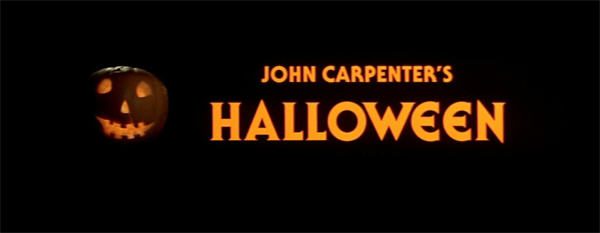
In fact, it had been some time since I’d last seen this film, and I’d watched an unusual (for me) number of true slashers in the interim; and I was frankly startled at just how clearly the bare bones of your average slasher plot show through the polished surface of John Carpenter’s mini-masterpiece.
As is the case with the other highly influential films, Halloween wasn’t really the first of its type, although it did come mighty close. Apart from prototypes both domestic and foreign (Psycho and its mostly British imitations on one hand, and numerous gialli on the other), the Canadian thriller Black Christmas preceded Halloween by four years, but didn’t catch on with horror fans the way the later film did; and so it was Halloween that ultimately laid down “the rules” for the flood of copies that were to follow. Given that most of these “rules” are precisely the reason why slasher films are treated with such opprobrium, it is worthwhile stopping to consider (i) just what those rules are; and (ii) what it was about Halloween that made it possible for the film to dodge the hail of bullets that, almost without exception, greeted the release of its many, many imitators.
If we’re going to talk about the slasher film rules, we may as well start with the big one: have sex and you will die. This convention, as much as anything else, encapsulates the slasher film; and it is Halloween that is largely to blame for it, even though it does not take the idea to the extremes that many of its descendants do.
(The Friday The 13th franchise is perhaps most guilty in this respect, not in killing only its sexually active characters, but in saving for them its most gruesome deaths. Remember the arrow from under the bed in the original? The mid-coital impaling in Part 2? The machete bisection in Part 3?…)
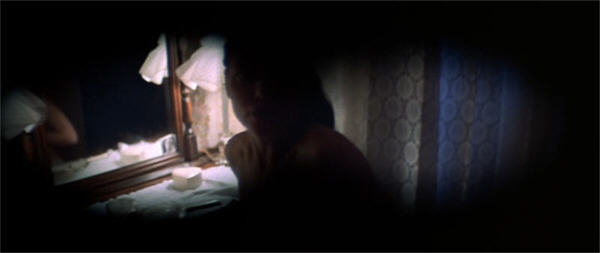
Most of the moral outrage against slashers stems from this recurring theme, along with the fact that the murders themselves too frequently feature the protracted stalking of semi-clad or naked girls.
So intent are many commentators upon condemning this practice that it never seems to occur to them to consider just how peculiar a practice it is. Why would films aimed primarily at a young audience so consistently be built around a message that, let’s face it, no young person would really want to hear? The very repetition of the theme is the strongest indication, I believe, that it is not generally intended as some kind of moralistic warning. On the contrary. Most slasher films exist to show blood and boobs, and what better way of doing so than by juxtaposing a sex scene with a murder?
That said, there are some films that use this juxtapositioning not merely exploitatively, but punitively. I’m often asked why I come down like a ton of bricks on this film, and let that film off the hook, and all I can answer is that I feel a difference between them. Some films seem to me to be harmless in their intent (“Okay, we’ve had boobs – now bring on the blood!”); while others give off an intense and frightening vibe of, “Take that, you bitch!” The former I am prepared to let pass with a sigh and a shrug; the latter I will continue to land on, as hard as I possibly can.
Halloween created the template for much of what was to follow by having its main character, its “Final Girl”, a virgin by implication if not by declaration, and by making all of its victims not just sexually active, but apparently incapable of thinking of anything but sex. John Carpenter and Debra Hill claim that the film’s “sex = death” message was unintentional, and up to a point, I believe them; although Carpenter hasn’t exactly helped his case with asinine statements like, “The one girl who is most sexually uptight just keeps stabbing the guy with a long knife. She’s the one that’s killed him. Not because she’s a virgin, but because all that repressed sexual energy starts coming out.”

(Wow, and there was me thinking that Laurie stabbed Michael because he was trying to kill her!! Shows what I know, huh? [*rolls eyes*])
The problem is that, unintentionally or not, Halloween does project just such a message, due to a combination of factors that would also get handed down to future generations of slashers. The first is that we are never allowed inside the head of Michael Myers; and because of this, the emphasis is shifted from the killer to his victims and their so-called “transgressions”.
In the opening scene, Michael sees his sister kissing, then going upstairs with her boyfriend. After the boyfriend leaves (this may, by the bye, constitute the quickest “quickie” in screen history, taking the same amount of time as it does for Michael to walk to the kitchen and pick up a knife!), the child goes upstairs. He sees the rumpled bed sheets, and he sees his sister almost naked. He kills her.
Later, Michael spies on Annie as she strips off her stained clothing in the kitchen, and kills her as she sets off to collect her boyfriend. This incident is both interesting and worrying: we know that Annie’s purpose is S-E-X, but Michael does not. Possibly Annie’s stripping makes Michael identify her with Judith; but either way this scene plays as if she were being punished for her intended “sin”.
Finally, Michael watches as Lynda and Bob have sex, then kills them both – Lynda after she flashes her breasts at him (she thinks she’s flashing Bob, of course). We are never given any reason for any of this, beyond Dr Loomis’s insistence that Michael is “evil”—and it is hard to imagine just how a six-year-old could have developed such an intense sexual psychosis. By rights, all this should mean that it is evil to kill people because of their sexual activity; and yet it never plays like that. The unmistakable inference is that Michael’s victims “asked for it”.
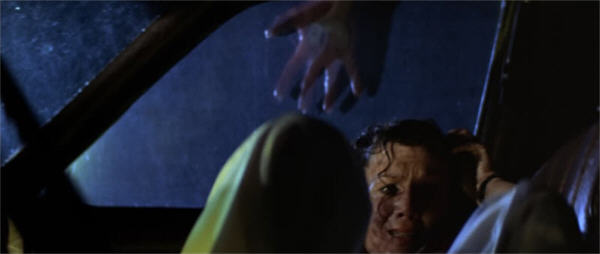
The fact of the matter is, however, this inference comes about almost entirely as a result of poor writing. None of the minor characters in Halloween are particularly well-developed, and this includes Annie and Lynda. While they are better written and more realistic than most of the teenagers in the slasher films that followed – talk about being damned with faint praise! – nevertheless the two of them think about, talk about and shape their behaviour around nothing but having sex. (This also applies to Lynda’s boyfriend, Bob, but he barely qualifies as a “character”.)
Now, I know that some of you – perhaps most of you – will be out there protesting, “But that’s how teenagers are!” The problem I have with that is that I remember very clearly when my friends and I were seventeen, and we managed to think about, and occupy ourselves with, a great many things besides sex. School, friends, movies, music, sport, jobs, hobbies— Sex was often a long way down the list, and frequently didn’t get a guernsey at all.
Consequently, when I see sex-obsessed characters like Annie and Lynda in a film, it strikes me not as realism, but as lazy, exploitative writing (or as adults trying to re-write their own pasts). Annie and Lynda, like Judith Myers, exist only to get nekkid, have sex, and die. The lack of any shading in their characterisations makes it very difficult to take the protestations of Halloween’s screenwriters at face value.
Where Carpenter and Hill redeem themselves – and where Halloween distances itself from the vast majority of its imitators – is in the character of Laurie Strode. In Laurie, we have one of, perhaps the most thoughtfully and believably written teenager in the whole horror genre. In later years, mere virginity was enough to qualify a slasher film character as Final Girl: as long as she didn’t have sex, she could be as annoying, obnoxious and boring as she liked. If Halloween dictated that its Final Girl should be a virgin, it also made Laurie a great deal much more than that.
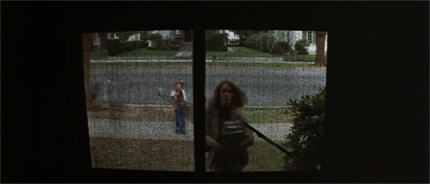

First and foremost – Laurie is intelligent (she gloomily claims that she’s “too smart” to attract boys). She works hard at school, worries about her homework, and is trustworthy and reliable as a babysitter. She is, in a word, responsible; and wonder of wonders! – none of this is presented as a strike against her. On the contrary, it is these very qualities that ensure her ultimate survival, not that pesky virginity.
And what of that? The script makes it clear that it’s only circumstantial. Laurie does think about boys; she does think about sex. But – she’s a little bit shy, and a little bit awkward, and a little bit of a loner. In some ways she envies her friends’ free and easy behaviour, but is unable to bring herself to imitate it.
(One of the main reasons, I believe, for the enduring popularity of Halloween is that young viewers identify very strongly with Laurie. While a lot of film-makers try to have us believe that teenagers like Laurie are unusual, I think that the reverse is true; and that over the years a great many kids have seen an awful lot of themselves reflected in Laurie Strode.)
We should pause here for a moment and pay tribute to what Jamie Lee Curtis brings to Halloween. Would the film have been as well-received, or maintained its status over the years, without her? Honestly, I doubt it. The character is well-written, yes, but equally important is the personality that Curtis brings to her role, as well as the way she fleshes Laurie out over the course of the film. This was her film debut, and she’s disarmingly good; a little awkward at times, certainly, but this is so much in character that you don’t tend to notice at first it isn’t acted. What she creates here is a gift to the viewer all too easy to undervalue—until, perhaps, that same viewer has sat through a raft of other horror films where the predominant response evoked is a passionate desire to see the entire cast killed as horribly as possible, as quickly as possible: namely, a character who is immediately and easily likeable and sympathetic.

In short, Curtis’s Laurie Strode is that great slasher film rarity: a nice person. This is highlighted during the babysitting scenes, where it becomes clear that Laurie takes these jobs not just for the money, but because she genuinely enjoys her charges’ company, and likes making them happy. Annie, of course, takes a babysitting assignment only because she has nothing better to do, i.e. sex, and fulfils her duties by depositing her charge in front of the television. The moment her boyfriend is un-grounded, she abandons the girl to Laurie’s care.
And this dovetails into another facet of Halloween that separates it from the pack: that when the danger strikes, Laurie’s first thought is always for the kids; she fights back as much to defend them as to defend herself. This, too, is a reflection of Laurie’s sense of responsibility; and to be honest, I’ve always felt that what Carpenter and Hill were aiming at in Halloween was a contrast between Laurie’s responsibility, which results in her survival, and her friends’ irresponsibility, which results in their deaths. However, because that irresponsibility is defined almost entirely in sexual terms, the true moral of the film (if it can be said to have one) is perverted.
The other thing that distinguishes Laurie is that she is observant. While most Final Girls are unaware of danger until they start stumbling over their friends’ bodies, Laurie is conscious of lurking danger right from the outset. She notices the car, and the silent watcher who seems to be following her. On a subconscious level at least, she is armed for conflict from the beginning. It has always jarred on me that Laurie dismisses out of hand Tommy’s repeated claims that, “The Boogeyman’s out there!” After her experiences of the day, Laurie should have believed—not, of course, that a monster was nearby, but that someone was. It would have been more believable had she taken Tommy’s fears seriously, while concealing from him that she did.
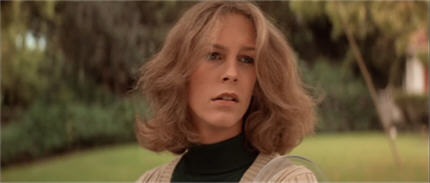
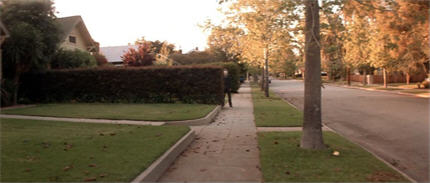
The “killer’s POV” shot certainly did not originate with Halloween (like most things in the American slasher film, it has its roots in the Italian gialli), but the film puts it to remarkable use; and this technique quickly became a slasher standard. Most critics have, I feel, over-read this convention, interpreting it as a deliberate attempt to make the viewer identify with the killer, rather than seeing it for what it actually is, at least most of the time: the simplest way of concealing the killer’s identity.
The opening scene of Halloween is justly famous, as the camera prowls around a house, enters it, climbs the stairs, records a murder, and retreats – only then revealing the killer’s identity. This extraordinary tracking shot has now been copied more times than anyone could possibly count, and yet it retains all of its power. Indeed, much of Halloween’s success must be credited to one of the wisest technical decisions in the annals of the horror film: the hiring of Dean Cundey and his Panavision equipment. (I would imagine that this is where the production blew most of its tiny budget.) Cundey’s contribution to the film really cannot be overestimated. His eerie, gliding camerawork, his use of shadow and his lighting effects, combined with John Carpenter’s endlessly inventive deployment of the corners of the frame, make this a film of intense visual appeal.
Halloween is also distinguished by some simply indelible images. While most people seem to cite “dead” Michael sitting up behind Laurie as their most vivid memory, for me, the shot of the film is the slow emergence of Michael’s white mask from out of the darkness beside Laurie, as she sits sobbing after the discovery of her friends’ bodies. Running this a very close second, however, is the bizarre tableau of Annie’s body on the bed, a gravestone at her head, illuminated by jack o’ lanterns. There is a surreal quality about this image that seems more European than American; and indeed, Carpenter has referred to Halloween as his “Argento film”. But while this may be an apt description of the film’s look, it could not be more inaccurate as a description of either its body count or, in particular, its bloodshed.
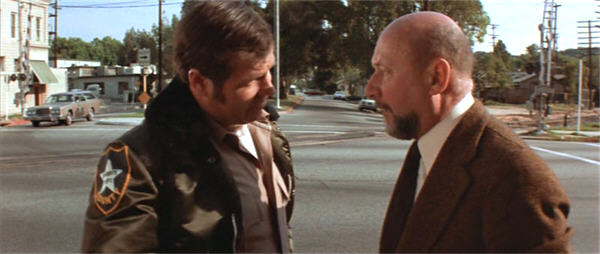
If the fact that the makers of Halloween invested a great deal of thought and care into their creation puts a gap between it and its descendants, the film’s attitude towards its murders turns that gap into a yawning abyss. Nothing illustrates the difference between Halloween and a true slasher better than the fact that in the course of the film, you barely see a drop of blood spilled – even when, by rights, you certainly should (Bob’s murder, most specifically). There could hardly be any stronger proof that this was intended purely as a horror film, a “fright film”, and not as an exercise in the gross-out.
Unfortunately, the majority of those who chose to cash in on Halloween’s success had neither the talent nor the inclination to follow Carpenter’s subtle lead; and two decades of escalating graphic gore effects followed – most of them embedded in films of numbing stupidity and crassness. The true pity of this, I think, is that many genre fans believe that this is what “horror” is – and will tell you, if you ask, that Halloween is boring – poor unimaginative little dweebs…
Carpenter’s creation of Michael Myers, “the Shape”, evil incarnate, call him what you will, has also had a far-reaching, if not particularly profound, effect upon the horror genre. While most copyists have adopted the “unstoppable killer” purely as an easy set-up for a sequel – or worse, for a “it isn’t over” kicker ending – it is clear that Carpenter intended Michael to be something more.
There is a tone-setting moment fairly early in the film, in which Laurie responds to a question from her teacher by defining two different views of “fate”: one in which it is a religious force, the other in which it is a force of nature. It is not difficult to interpret this scene as a foreshadowing of the conflict to come, with Michael representing the irresistible force, Laurie the immovable object. In this respect, I’ve always suspected that the emphasis on Laurie’s virginity was not actually intended merely as a sexual reference, but more as an indicator of “purity” in the mythic or fairy-tale sense; as a balance to Michael’s “evil”.

If so, this is one more casualty of the poor delineation of the supporting cast: thrown into relief as it is by the slaughter of all the sexually active characters, it becomes difficult to think of Laurie’s virginity in anything but crudely sexual terms. Nevertheless, it is possible to read Michael’s seeming inability to kill Laurie as a result of her being under some kind of supernatural protection.
Michael himself, of course, survives a knitting needle to the throat, a knife in the chest, six shots and a fall from a second-storey balcony; while the film repeatedly suggests that there is something not just evil but fundamentally inhuman about him—such as the revelation that he has killed and eaten a dog. The film closes with a montage of images – the places Michael has been; the places where, perhaps, he still is. “That was the Boogeyman,” sobs Laurie, and Michael’s pursuer and would-be nemesis agrees, “As a matter of fact, that was.”
“Every small town has something like this happen,” comments the graveyard attendant to Dr Loomis of Judith Myers’ murder, and this may be the key to Michael. It is worth remembering that Michael is always masked when he commits his misdeeds; that Laurie inadvertently saves her own life by tearing off his mask. Perhaps, then, Michael represents the potential for tragedy that can lurk beneath the placid surface of any community; and which may ultimately be all the more violent for being too long repressed or ignored.
The pursuit of Laurie Strode by Michael Myers is terrifying in its randomness. That Laurie being in the wrong place at the wrong time – her delivery of the key to “the Myers place” – is enough to make her the target of a psychopath is a touch that now resonates all the more strongly for society’s increased awareness of stalkers and serial killers and their ways.
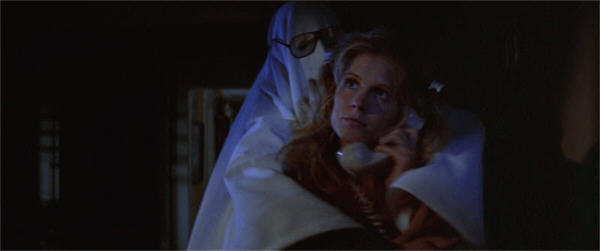
(Of course, the Halloween sequels made the incredibly wrong-headed decision to provide us with an “explanation” for Michael’s targeting of Laurie; but for the moment, we’re all going to pretend that never happened, okay?)
The introduction of Laurie, and her unknowing contact with Michael, is both beautifully shot and a wonderful piece of economical story-telling, with her walk through the streets of Haddonfield emphasising the usual serenity of the neighbourhood, so soon to be shattered, and Michael’s glimpse of Laurie and Tommy Doyle through the shaded glass of the Myers house deliberately echoing the audience’s view of the opening murder, filmed through the eyeholes of a Halloween mask. Unfolding in the aftermath of Dr Loomis’s wild cry, “The evil is gone from here!“, this sequence has a wonderful shivery quality. Michael’s immediate emergence from the house lets us know that Laurie has been “marked”—and perhaps not her alone.
It is intriguing that Michael’s stalking of his potential victims includes the young Tommy – although he never seems to have any real intention of harming the boy. It is possible that Michael actually empathises with Tommy; certainly, his presence near the bullying scene is suggestive. The film gives us several indications that while Michael’s body has grown, his mind has remained that of a child. One is his abortive “joke”, appearing before Lynda draped in a sheet and wearing Bob’s glasses, then standing without moving as if unable to think of what to do next. Another – and this is one of the film’s truly great moments – comes as Michael stands before Bob’s dangling body, his head tilting his way and then that as he contemplates his handiwork.
The other act that might possibly be interpreted as a joke on Michael’s part is his gathering together of his victim’s bodies, before luring Laurie into their presence. Subsequently, the Final Girl finding her friends’ bodies would become a defining slasher film motif, being used there, as here, to signal the beginning of “end game”.
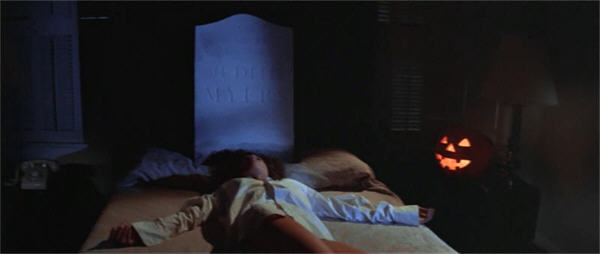
Perhaps the single most frightening scene in Halloween comes when Laurie, having smashed her way out of the Wallace house, pounds on the Doyles’ front door, shrieking for Tommy to let her in, with Michael closing in on her from across the street. (At any rate, this scene impressed the makers of I Know What You Did Last Summer so much that they reproduced it wholesale.) The gruelling showdown between Final Girl and Killer is one of Halloween’s most obvious cinematic legacies – right down to the Final Girl’s refusal to finish off the Killer when she has the chance! Today, of course, it is impossible to react to Laurie’s relinquishing of the knife – which she does not once, but twice! – with anything but anguished cries and hair-clutching; but then, poor Laurie didn’t have two decades of copy-cat films to teach her better, did she?
(If there’s anyone out there who saw this film in 1978, and remembers how they reacted to Michael’s resurrections and Laurie’s knife-droppings, I’d really like to hear from them!)
Halloween is an elegant and chilling little horror film. While much of its power can be attributed to its direction and its cinematography, due credit must also be given to John Carpenter’s score which, while fairly simply and repetitive, is also surprisingly effective, adding tension to even those scenes in which not much appears to be happening. It operates in a manner similar to the use of “Tubular Bells” in The Exorcist: minimalist, but disturbing.
However, with all of its virtues, the film does have some very obvious flaws. Its pacing is rather uneven, with things dragging noticeably before Michael really gets down to business. In addition, some side-effects of the low budget, more specifically of the short shooting schedule, show a little too clearly. While the shots of Haddonfield’s broad, tree-lined streets are richly atmospheric, there is some very poor matching of blue skies and grey skies, rain-damp streets and dry ones. And, oh yes, “Haddonfield”: pity about all the California license plates – and the fact that the temperature seems rather warm, and the trees a little too green and flourishing, for Illinois in late October…
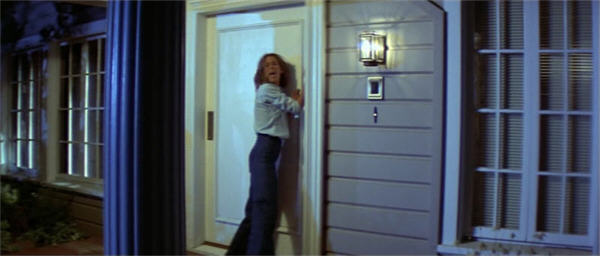
Still, these are minor details compared to some of the contrivances of the story. That even John Carpenter was uncomfortably aware of these is evident in the throwaway exchange about Michael’s ability to drive a car: “He was doing very well last night!” pronounces Dr Loomis, when an administrator at the hospital insists that Michael couldn’t make it as far as Haddonfield, and the subject is dropped. Personally, the one thing about Halloween I have always found impossible to swallow is not Michael’s automotive skills, but Laurie’s utter refusal to switch a light on when she enters the Wallace house – I mean, even if you did think it was your friends playing a practical joke, wouldn’t you turn on as many lights as possible in that situation? (And the power is on; that’s demonstrated for us elsewhere.)
The other obvious plot device is the near total absence of any adults in the story – something else that would be slavishly imitated by Halloween’s descendants. Indeed, the fact that two of the film’s young characters are seen to have parents is, in this context, fairly remarkable. However, only Annie’s father, Sheriff Brackett, gets anything resembling significant screentime.
(He also gets the film’s most poignant moment, responding to Dr Loomis’s explanation of the situation with a bitter, “If you are right, damn you for letting him go!” – a line spoken in ignorance of the fact that his daughter has already become one of Michael’s victims.)
Almost every other adult in Haddonfield seems to have decided to have a night out. Do American parents really choose Halloween, of all nights, to go out en masse and leave their kids with teenaged babysitters? It seems rather unlikely to me. And as for the adults that do stay home— Could anyone actually mistake Laurie’s hysterical screams for help for a practical joke? Even on Halloween? In fact, particularly on Halloween, in a town haunted by an earlier Halloween-night murder?

But let’s face it, Halloween isn’t a work of art, just an admirably effective horror film. I’m sure the endless thousands of people who flocked to see it weren’t looking for high art, but rather, to get the bejeezus scared out of them; and that, they probably got.
Along with Jamie Lee Curtis as Laurie, Halloween‘s other great pleasure is Donald Pleasence’s performance as Dr Loomis, which is quite unforgettable; in a sense, it’s a great shame that he didn’t abandon the Halloween franchise here, as it is unjust that in many people’s minds, he is more associated with the inferior sequels than with the epoch-making original. John Carpenter originally wanted Christopher Lee for the role, but Lee’s persona would have shifted the film’s dynamic completely, and not for the better. Donald Pleasence’s breathless, fluttery delivery of his rich and fruity dialogue is indelible – making us aware of the danger that threatens Haddonfield while simultaneously suggesting that the good doctor himself has a few kangaroos loose in the top paddock; not surprising, of course, considering that he has spent fifteen years in close contact with “evil incarnate”.
(One of the film’s sweetest touches comes as Loomis waits for Sheriff Bracken after the robbery, agitatedly peering this way and that, and Michael drives right past him.)
The rest of the cast is solid, but certainly not particularly memorable. In fact, two of the better performances come from the two youngest actors, Brian Andrews as Tommy and Kyle Richards as Lindsey. For the record, my identification figure in Halloween is the young Lindsey Wallace: anyone who has to be in actual physical danger before she can be dragged away from a double-bill of The Thing and Forbidden Planet is okay by me. Mention should also be made of Nick Castle’s silent, body-language performance as The Shape, which is thoughtful and genuinely unsettling.
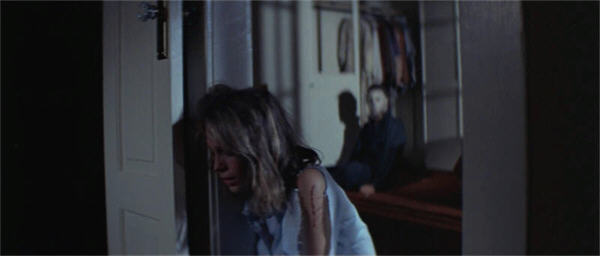
So how did Halloween, a good and successful, even tasteful, little horror film, end up spawning so many crude, ugly, outright bad imitations?
The answer is double-barrelled. Firstly, and most significantly, Halloween made an absolute fortune. In fact, it quickly became the most profitable independent film of all time, a title it took away from Grizzly and would hold until The Blair Witch Project was released in 1999.
Secondly – Halloween is quite a simple film. It stands out from the crowd because of the commitment and technical skill that went into making it; but if you strip those things away, really, it could hardly be simpler. If the lure of the dollar drew many aspiring film-makers to the slasher film, the fact that such a project seemed – stress, seemed – to require very little thought – or effort, or talent – was probably the final determining factor. Although productions such as The Toolbox Murders and Terror Train (also starring Curtis) immediately followed Halloween, it was the release of Friday The 13th in 1980 that opened the floodgates. Substituting that film’s only real virtue, Tom Savini’s gore effects, for John Carpenter’s carefully staged scare scenes, Sean Cunningham’s exercise in cynicism was nevertheless enormously successful – and sent the horror genre as a whole into a dispiriting downward spiral.
And if this is depressing, even more so is the subsequent fate of Halloween itself. What is truly startling when watching the film these days is how patently its open ending was not intended to set up a sequel, but rather, merely to leave the audience with the uncomfortable feeling that “the evil” was still out there.
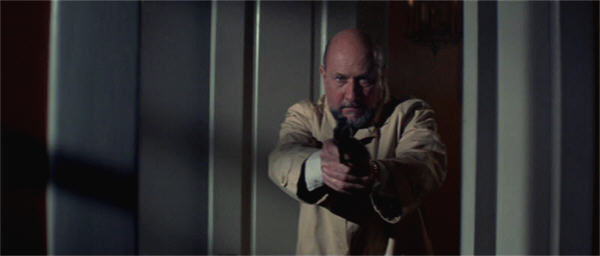
Unfortunately, when it became apparent that everyone else in the horror field was cashing in on Halloween far more than they had, the film’s production team was unable to resist the temptation of bringing back their creation. Despite being made by essentially the same people, Halloween II is a pale shadow of the original, with gore scenes and gratuitous nudity in the place of genuine scares, and only Dean Cundey’s cinematography holding the project together. It is doubtful whether we’ve ever had a more graphic illustration of the difference between a film made with love and fueled by enthusiasm, and one driven purely by economics.
Want a second opinion of Halloween? Visit 1000 Misspent Hours – And Counting and Jabootu’s Bad Movie Dimension.

I’ve always assumed Myers went after Annie before Laurie for a reason, namely her snotty crying out of “Speed kills” as he drove past the two earlier in the film. It’s probably not a coincidence Myers lay in wait in the car for her.
LikeLike
…although how he got into the car is another of the film’s little mysteries.
That may be true but he waits until after he’s watched her get undressed to do anything.
LikeLike
I lived in South Pasadena during my teenage years and one of my few true geek out moments was when I realized the sheer amount familiar locations used in the film. Some of it actually looks the same to this day though the high school has been completely refurbished. It kind of bums me out though to think that I’m the same age as this damn movie.
LikeLike
Ya damn kid! 😀
I get the same sort of freaky feeling from Howling 3: I don’t get into the city much these days and the image of it that film presents is more or less what’s in my memory, though I know that entire area has been completely altered since.
LikeLike
Mad Magazine did a spoof of slasher movies, and the Final Girl, after being invited to the picnic (of DEATH!), responds, “well, I had planned on reading Plato’s Republic, but ok!” A side note informs us that the only survivor will be the Smart Virgin, which will give parents the impression that there is an important message here.
LikeLike
You mean there isn’t!? 😀
LikeLike
I’m with you on the shot of the film, Lyz. While the head-tilting is the most disturbing moment for me, Michael’s mask ghosting out of the shadows was one of the biggest frights a movie has ever given me, and I didn’t see it until my early 20s. It was the way it subverted what I was expecting, I think. I totally expected him to appear there, but there’s just enough of a pause that I doubted myself; I also expected him to lunge out at her, not to slowly materialize the way he does. I can only think of three movies that scared me more. For the record, they’re The Exorcist, Alien, and Jaws. I was very young when I wandered into the living room while the first was on the television; while I don’t remember what I saw, I do remember that it made me hide behind a piece of furniture and refuse to come out. The second was the chest-burster scene, naturally. The last was not one of the two scenes you always hear about, although both did their jobs as well; it was the shot of the shark rising from the depths toward the guy struggling to get back in his rowboat. It’s the first good look we get at the shark and its size; and that gaping, fanged maw coming for that poor unknowing bastard…that first time, I was actually paralyzed from sheer fright; to this day it makes my nape hairs stand straight up.
Back to Halloween, I was actually kind of glad I’d seen quite a few slasher movies prior to it, as it afforded me a chance to appreciate where a good portion of their framework came from, while at the same time giving me things the slashers to come rarely did, I suppose due to the relative talent Carpenter and his cast brought. I can think of a couple that had good scare moments, although none provide the constant, creeping dread this movie gives us; very few have really talented actors; the killers may be memorable, but are almost never as effective as Michael; and truly this movie gave us the Final Girl by which all others must be judged.
Along with El Santo’s, you should also link to Ken’s piece on this movie, which I assume you have read. His hypothesis on Michael is brilliant.
LikeLike
Yes, thank you for reminding me of that: I was having trouble accessing it and meant to contact Ken to see if the issue was his end or mine…but then forgot to follow up, as so often. (Ze brain, she does not function…)
(ETA: It’s working now, so it must have been me. Link added, thanks again!)
this movie gave us the Final Girl by which all others must be judged
Funny you should say that… 😀
LikeLike
I wasn’t able to access his site for a time yesterday, so probably on his end. I am able to access his review right now as I type this.
Funny you should say that…
Oooo, a mystery! What does Lyz mean by this?
I was going to expand on that line and talk about the only FGs that are anywhere in the ballpark with Laurie Strode, but as we can all see I wrote more than enough as it was. Maybe I’ll get to in the near future?…
LikeLike
Wellll, I have yet another side project in mind, so it might be better for both of us to hold that thought for a later time. (You can then argue with my heretical opinions…)
LikeLiked by 1 person
“Heretical”? Are you going to claim someone else as a better final girl?
Someone with a, shall we say, steely personality? 😉
Well, now I hope this side project pans out; I’m very interested in seeing what this is all about!
LikeLike
Someone very much like that, yes. 😀
I hope so too, although I say that in full and dismayed awareness of the way the list of potential side-projects keeps multiplying on itself…
LikeLike
Well now I REALLY hope it does, so I can find out who you’re referring to if it’s not her! I’m already going through runners-up in my head, and wondering if you’ve even seen the movies they’re in; or if you’ve got one I actually haven’t seen yet.
So much for sleep tonight…
LikeLike
Go to sleep, you fool – it’s her! 😀
LikeLike
This isn’t like that time you posted a review at ~2 a.m. my time and I had to read it before going to bed; it’s only about 10:45 here. 🙂 I just meant my brain would decide this was something to think about instead of letting me sleep. It happens to me a lot, and sometimes regarding even more inane things. Still, at least that won’t happen now. Due to this, anyway.
It was the wording “someone very much like that” that led me to believe it was someone else. Considering how much you like her*, I was really wracking my brain trying to think of who could have replaced her in your heart.
*For damn good reason, admittedly; she’d be a strong contender for runner-up in my opinion.
LikeLike
“The true pity of this, I think, is that many genre fans believe that this is what “horror” is – and will tell you, if you ask, that Halloween is boring – poor unimaginative little dweebs…”
Some years ago, my wife and I were in conversation with friends not yet born when Halloween was made, but who like horror films and don’t mind slashers. It developed that they had never seen Halloween, so after a quick explanation of its role as fount and Platonic ideal of the genre, we nipped the tape into the machine (yes, that long ago).
Blank looks at the conclusion. Shrugs. Alas, alas, these degenerate later ages we are living in.
LikeLike
I’m even more appalled at how being startled [loud noises, jump scares, etc] has been mistaken for scary. Being startled is not the same as being afraid, but modern film makers seem not to have learned the difference. Or worse, they don’t care because nobody wants to be haunted by a film anymore… just forced to jump so they can laugh at themselves and their friends and then forget the film an hour after seeing it.
Or, or — I’ve just become an old fogie.
LikeLiked by 1 person
No. It’s the children who are wrong.
LikeLike
…poor unimaginative little dweebs. 🙂
LikeLike
Yeah, but if you’re easily pleased you end up being pleased a lot of the time.
LikeLike
Oh, the REALLY!! LOUD!! NOISE!!—bane of my existence…
[old fogey]
You know, I blame Scream – and it’s propagation of the idea of the scary movie, as opposed to the horror movie – for a lot of what’s wrong these days. As you say, mot of the time it’s about 90 minutes of jump-scares, and then you laugh and forget about it.
[/old fogey]
LikeLike
The sad thing about that is the fact that the opening sequence of Scream is really damn good. It’s like they blew their wad early and had to resort to REALLY!! LOUD!! NOISES!! the rest of the movie. (I did jump at a couple of those, but that was due to being in an audience full of college students, many of whom were easily-startled females possessed of impressive lung capacity.) Still, I liked it enough overall to look forward to the sequel…which then enraged me so much that I gave up on the franchise then and there, a grudge I’ve held to this day.
LikeLike
I’m the most easily-startled female you could find, but I don’t scream or even gasp; sometimes I suck air in sharply, but mostly it’s just an actual physical start. Is screaming yet another “marker of appropriate femininity” that I don’t practise? (I’ll add it to the lo-oo-ong list of “Things all women do” that I don’t do…)
Opening sequence aside, I hate the attitude of Scream. I think the first two-thirds of Scream 2 are genuinely clever, and the last third some of the worst rubbish I’ve ever seen. (I’d love to know what happened there…) I haven’t watched the third one yet. A surprising number of people have warned me off it, but I suppose I’ll get to it some day.
LikeLike
The screaming is…acceptable in a large crowd like that, as it’s part of the experience. Honestly, though, I don’t need it. I certainly wouldn’t want it happening if we were watching something at home.
Face it, Lyz, you’re the Platonic ideal for “movie geeks.”
I didn’t really catch the attitude in the original until my second viewing, where I could concentrate more on it; since, as we know, watching it with a crowd is a completely different thing. I was pretty much of a like mind with the second one, which I only saw on DVD. I’ll have to reread your review; I can’t recall if your divide came when mine did or not.
LikeLike
Aww, thanks! 🙂
Ugh! I just want to grab that film by the collar and smack the smug grin off its face. Ugh!
To my mind there’s an absolutely clear turning point in the second one.
LikeLike
A long time ago I stumbled across the paperback novelization of Halloween, and the prologue set the tone really well. It explained the origins of The Evil, and made Michael’s supernatural indestructibility believable. The first film is the only one I’ve seen, and I have a vague understanding that the events in that prologue are shown in one of the sequels, but it’s absence takes away some exposition as to the nature of why Michael is the way he is.
LikeLike
That’s interesting! I’ve read a bunch of novelisations over the years (I own the bizarre Jaws2 one), but I haven’t come across this one. If/when I finally manage to go on with the later sequels, I should probably look into how far they draw upon that—and where those ideas came from.
LikeLike